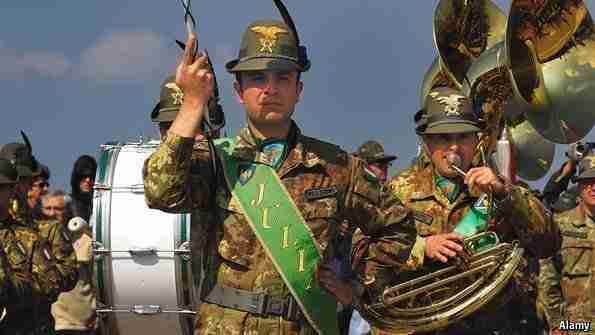
The grey felt cap adorned with a black raven feather worn by old northern Italian men and some modern-day camouflaged troops is known as the Cappello Alpino.
This recognizable cap signifies that the wearer is or was a member of the Alpini, an elite corps of the Italian army that is most closely associated with World War I and is the oldest mountain infantry in the world.
Formed in 1872 , 11 years after the unification of Italy, the Alpini were brought together to protect the peninsula’s mountainous borders with France and Austria.
Traditionally, Alpini soldiers have hailed from the same regions that they were chosen to protect: Val d’Aosta, Piemonte, Lombardia, Trentino Alto-Adige, Veneto, and Friuli-Venezia Giulia.
Today, the Alpini are best known for their assistance with earthquake and avalanche recovery, particularly in Central Italy along the Apennines, where the earth is shakier. Alpini have also been deployed to as far afield as Afghanistan and Kosovo, where they are able to use their expertise navigating mountainous terrain.
From their founding until after the second world war, the Alpini have seen their numbers rise and fall, as brigades were formed and disbanded according to military need.
At their height, there were dozens of Alpini brigades. Today, only two military brigades remain — the Taurinense, from Torino, and the Julia, from Udine. However, the National Alpini Association (Associazione Nazionale Alpini, ANA), acts as a reserve corps — a so-called 10th Italian army regiment — and has thousands of members from across Italy.

“With the centenary of the armistice ending the first world war fast approaching, the Alpini look set to return to the forefront of Italian cultural memory,” explains The Economist in a piece on the mountain men, which brings into particular focus the traditional songs of the Alpini.
In many towns in the northern regions of Italy, Alpini regiments come together during Christmas pageants and town fairs to sing Canti Alpini, melancholy songs about war, death, and pastoral mountain scenes.
But if some Alpini songs stumble towards chauvinism, their enduring reputation is down to their stark anti-war message. “A ‘happy’ death has never existed,” explains Massimo Marchesotti, conductor of the Alpini choir in Milan. “We sing about the truth: of the pointless death…that none of those kids chose for themselves.” The results are intensely moving. In “Oi Cara Mamma”, the Alpini ask what their mothers will do when their sons don’t come back. Elsewhere, the choir tells their lover that they are buried “in a field of edelweiss”. The choir concludes that “when you are alone at home, the edelweiss and I will be with you.”
Here is a video of the Alpini of the Tridentina Brigade (Brixen/Bressanone, Trentino-Alto Adige) singing the anthem of the Alpini (Inno degli Alpini), followed by the Italian National Anthem.
For many visitors to Italy, the particulars of World War I are unknown but for the monuments, memorials, and commemorative plaques of names that hang in nearly every city square from north to south.
A total of 17 million soldiers and civilians lost their lives during World War I. Approximately 1-1.2 million Italians, or roughly 3-3.5 percent of the population, perished due to military action or disease from 1915 to 1918.
To understand more about the Alpini role on Italy’s mountain front, have a look at this long read published by Smithsonian Magazine. The Most Treacherous Battle of World War I Took Place in the Italian Mountains follows a few World War I historians through the Dolomites.
“We’re in one of the most beautiful places in the world,” he said, “and one of the most horrible.”
Further reading on the Alpini and World War I:
- Associazione Nazionale Alpini (ANA)
- La Grande Guerra: 100 Anni della Prima Guerra Mondiale (Esercito Italiano)
- Il Fronte Dolomitico
- Vecio: Il Sito degli Alpini
- The Alpini Corps
- A Farewell to Arms (Ernest Hemingway’s novel set in World War I Italy)

This post was my contribution for the Italy Roundtable in which the theme was “Tradition.” Check out these posts from my Roundtable colleagues:
- Jessica – Italy Roundtable: How We Keep Our Balance
- Gloria – The new and the old and the olive oil festival
- Rebecca – Christmas Markets in Umbria: A New Tradition
- Alexandra – 7 Things you might not know are Made in Tuscany
Alpini photos from Wikipedia; The Economist
Last updated on May 17th, 2023Post first published on February 9, 2017






